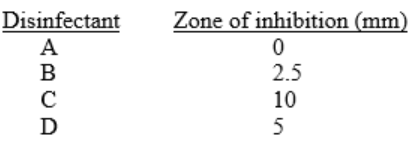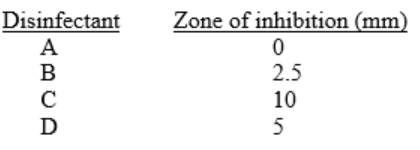Ch 7
1/51
There's no tags or description
Looks like no tags are added yet.
Name | Mastery | Learn | Test | Matching | Spaced |
|---|
No study sessions yet.
52 Terms
Sterilization
The process of removing or destroying all microbial life on an object.
Commercial Sterilization
Heat treatment of canned foods to destroy C. botulinum endospores.
Disinfection
The process of reducing or inhibiting microbial growth on a nonliving surface.
Antisepsis
The process of reducing or inhibiting microorganisms on living tissue.
Biocide
A substance that kills living organisms, particularly microorganisms.
Germicide
A chemical agent that kills pathogenic microorganisms.
Bacteriostasis
The inhibition of bacterial growth without killing the bacteria.
Asepsis
The absence of bacteria, viruses, and other microorganisms.
Sepsis
Bacterial contamination.
Death Curve
A graphical representation showing the constant death rate of bacterial populations subjected to heat or antimicrobial chemicals.
Susceptibility
The varying degrees to which different microbial species and life cycle phases are affected by physical and chemical controls.
Organic Matter
Substances that can interfere with heat treatments and chemical control agents.
Membrane Permeability
The susceptibility of the plasma membrane due to its lipid and protein components.
Denaturation
The process by which heat or chemicals damage proteins and nucleic acids in microbial cells.
Moist Heat
A method of microbial control that kills microbes by denaturing enzymes (e.g., boiling, autoclaving, pasteurization).
Dry Heat
A method of microbial control that kills by oxidation (e.g., direct flaming, incineration).
Filtration
The process of passing a liquid or gas through a filter to retain microbes.
Low Temperatures
Conditions that inhibit microbial reproduction but may not kill them.
High Pressure
A method that denatures proteins in vegetative cells.
Desiccation
The absence of water, which prevents microbial growth but allows some to remain viable.
Osmotic Pressure
The effect of high concentrations of salts and sugars that can lead to plasmolysis in microorganisms.
Ionizing Radiation
A type of radiation that penetrates deeply and ionizes water, forming reactive radicals.
Ultraviolet Radiation
A form of nonionizing radiation that causes DNA damage by forming thymine dimers.
Use-Dilution Test
A method to determine bacterial survival in a disinfectant's recommended dilution.
Disk-Diffusion Method
A technique to evaluate disinfectant effectiveness by measuring zones of inhibition on agar plates.
Phenolics
Chemical agents that injure plasma membranes and are used as disinfectants.
Biguanides
Agents that damage plasma membranes of vegetative cells.
Alcohols
Disinfectants that denature proteins and dissolve lipids.
Aldehydes
Effective chemical disinfectants that inactivate proteins.
Ethylene Oxide
A gas used for sterilization that penetrates materials and kills microorganisms by protein denaturation.
Prions
Infectious agents that are resistant to disinfection and autoclaving.
Gram-Negative Bacteria
Generally more resistant to disinfectants and antiseptics than gram-positive bacteria.
Nonenveloped Viruses
Typically more resistant to disinfectants and antiseptics than enveloped viruses.
bacteriostasis
inhibition of growth of bacteria without destruction
sanitization
the cleaning and disinfection of an area or an item
Describe the patterns of microbial death caused by treatments with microbial control agents
bacterial populations subjected to heat or antimicrobial chemicals usually die at a constant rate
longer exposure to lower heat can produce the same effects as shorter time at higher heat
Describe the effects of bicrobial control agents on cellular structures
alteration of membrane permeability, certain chemical control agents damage the plasma membrane by altering its permeability
Damage to proteins and nucleic acids, breaking hydrogen bonds and covalent bonds
Compare the effectiveness of moist heat (boiling, autoclaving, pasteruization) and dry heat
Moist heat kills microbes by denaturing enzymes
Boiling kills many vegatative cells and viruses within 10 min
Autoclaving is the most effective method of moist heat sterilization
Pasteurization is used for a short time to destroy pathogens without altering the flavor of food
Dry heat kills by oxidation
Describe how filtration, low temoeratures, high pressure, desiccation, and osmotic pressure suppress microbial growth
Microbes can be removed from air by high-efficiency particulate air filters
Membrane filters composed of cellulose esters are commonly used to filter out bacteria, viruses, and even large proteins
Explain how radiation kills cells
depends on its wavelength, intensity, and duration
Ionizing radiation has a high degree of penetration and exerts its effect primarily by ionizing water and forming highly reactive hydroxyl radicals
UV radiation has a low dregree of penetration and causes cell damage by making thymine dimers in DNA that interfere with DNA replication
Microwaves can kill microbes indirectly as materials get hot
List the factors related to effective disinfection
concentration of disinfectant
degree of contact
temperature
Identify the methods of action and preferred uses of chemical disinfectants
Phenolics are suitable agents for disinfecting pus, saliva, and feces.
Biphenols- used to control infections in nurseries, and is an ingredient in soaps, toothpastes, and mouthwashes.
Biguanides- affect bacterial cell membranes. common in microbial control on skin and mucous membranes and is used in surgical hand scrubs.
Essential oils- similar to phenolics. can be used to disinfect hard surfaces like countertops and can be used on skin.
Alcohols- kill bacteria and fungi but not endospores and nonenveloped viruses. It denatures proteins usually, but can also disrupt membranes.
Heavy Metals- can be biocidal or antiseptic
Which of the following best describes the pattern of microbial death?
The pattern varies depending on the species
The cells in a population die at a constant rate
The pattern varies depending on the antimicrobial agent
All the cells in a culture die at once
Not all of the cells in a culture are killed
The cells in a population die at a constant rate
Which of the following pairs of terms is mismatched?
sterilant-destroys all living microorganisms
virucide-inactivated virus
bacteriostatic-kills vegetative bacterial cells
fungicide-kills yeasts and molds
germicide-kills microbes
bacteriostatic-kills vegetative bacterial cells
Which of the following does NOT achieve sterilization?
ethylene oxide
dry heat
autoclave
pasteurization
pasteurization
An agent used to reduce the number of bacteria on a toilet would most accurately be called a(n)
antiseptic
fungicide
aseptic
virucide
disinfectant
disinfectant
Which of the following is the best method to sterilize heat-liable solutions?
autoclave
membrane filtration
pasteurization
dry heat
membrane filtration
Which of the following methods is used to preserve food slowing the metabolic processes of foodborne microbes?
nonionizing radiation
ionizing radiation
freezing
lyophilization
pasteurization
freezing
All of the following factors contribute to hospital-acquired infections EXCEPT
-some bacteria metabolize disinfectants
-gram-negative bacteria are often resistant to disinfectants
-None of the answers are correct; all of these factors may contribute to hospital-acquired infection
-invasive procedures can provide a portal or entry for bacteria
None of the answers are correct; all of these factors may contribute to hospital-acquired infection

In Table 7.1, which compound was the most effective against Staphylococcus?
c

A disk-diffusion test using Staphylococcus gave the following results:
Which compound was the most effective against E.coli?
The answer cannot be determined based on the information provided

In table7.2, which preservative is most effective?
potassium sorbate + sodium benzoate